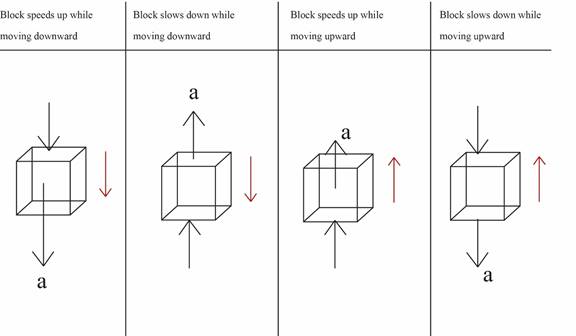
Concept explainers
Draw an arrow to indicate the direction of the acceleration of hic block for each of the four motions listed below.

To Draw:An arrow to indicate the direction of the acceleration of the block for each of the given four motion.
Answer to Problem 1aTH
The direction of acceleration is along the same direction to which the block speeds up.
Explanation of Solution
Direction of acceleration depends on the direction along which the block speeds up.

Here, a is the acceleration and its direction is along the direction along which the block speeds up. Red arrow indicates the direction of motion of the block.
Want to see more full solutions like this?
Chapter 16 Solutions
Tutorials in Introductory Physics
Additional Science Textbook Solutions
Essential University Physics: Volume 1 (3rd Edition)
The Cosmic Perspective
University Physics Volume 2
Conceptual Integrated Science
College Physics: A Strategic Approach (4th Edition)
Physics for Scientists and Engineers with Modern Physics
- Draw the before and after kinematic diagrams of the block after it hits the spring.arrow_forwardGive an example situation that is being described from the motion diagramarrow_forwardAs shown, match each υx–t graph on the top with the ax–t graph on the bottom that best describes the motion.arrow_forward
- Dynamics What the velocity at (B)arrow_forwardMatch the incomplete motion map below to the appropriate letter for a velocity-time graph. It is known that the object is moving toward the right. (The rightward direction is the positive displacement direction.) -Enter the appropriate letter into the answer blank.arrow_forwardMatch the incomplete motion map below to the appropriate letter for a velocity-time graph. It is known that the object is moving toward the left. (The rightward direction is the positive displacement direction.) -Enter the appropriate letter into the answer blank.arrow_forward
- show steps pleasearrow_forwardFor the motion described below, draw the corresponding d-t graph and v-t graph: I JUST NEED THE LAST TWO ANSWERED. NEGATIVE AND POSITIVE ACCELERarrow_forward1. Using the position-time graph below, calculate the velocity (slope) for each time interval below.Show all your work including directions and units A) Velocity from pointA to B B) Velocity from B to C C) Velocity from C to Darrow_forward
- The options for these are all abc. Please explain it and answer it. Thank you! I'm confused with the abs value of velocity consisting displacementarrow_forwardPlease solve the last question using KINEMATIC EQUATIONS and explain. I do not understand the formula used to solve for muzzle velocity.arrow_forward
 Glencoe Physics: Principles and Problems, Student...PhysicsISBN:9780078807213Author:Paul W. ZitzewitzPublisher:Glencoe/McGraw-Hill
Glencoe Physics: Principles and Problems, Student...PhysicsISBN:9780078807213Author:Paul W. ZitzewitzPublisher:Glencoe/McGraw-Hill
